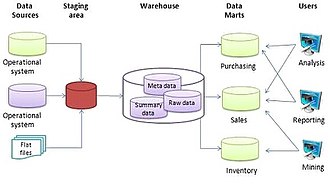
In computing, a data warehouse (DW or DWH), also known as an enterprise data warehouse (EDW), is a system used for reporting and data analysis and is a core component of business intelligence.[1] Data warehouses are central repositories of data integrated from disparate sources. They store current and historical data organized so as to make it easy to create reports, query and get insights from the data.[2] Unlike databases, they are intended to be used by analysts and managers to help make organizational decisions.[3]

The data stored in the warehouse are uploaded from the operational systems (such as marketing or sales). The data may pass through an operational data store and may require data cleansing for additional operations to ensure data quality before it is used in the data warehouse for reporting.
The two main approaches for building a data warehouse system are extract, transform, load (ETL) and extract, load, transform (ELT).
- ^ Dedić, Nedim; Stanier, Clare (2016). Hammoudi, Slimane; Maciaszek, Leszek; Missikoff, Michele M. Missikoff; Camp, Olivier; Cordeiro, José (eds.). An Evaluation of the Challenges of Multilingualism in Data Warehouse Development. International Conference on Enterprise Information Systems, 25–28 April 2016, Rome, Italy (PDF). Proceedings of the 18th International Conference on Enterprise Information Systems (ICEIS 2016). Vol. 1. SciTePress. pp. 196–206. doi:10.5220/0005858401960206. ISBN 978-989-758-187-8. Archived (PDF) from the original on 2018-05-22.
- ^ "What is a Data Warehouse? | Key Concepts | Amazon Web Services". Amazon Web Services, Inc. Retrieved 2023-02-13.
- ^ Rainer, R. Kelly; Cegielski, Casey G. (2012-05-01). Introduction to Information Systems: Enabling and Transforming Business, 4th Edition (Kindle ed.). Wiley. pp. 127, 128, 130, 131, 133. ISBN 978-1118129401.